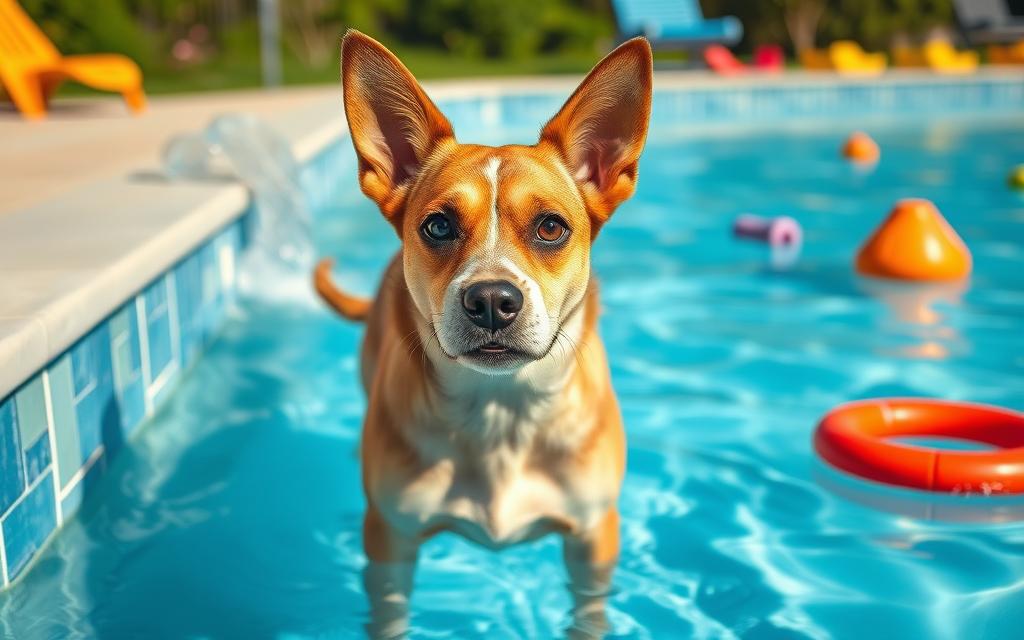
Why Some Dogs Hate Water. Did you know that 25% of dogs really don’t like water? This makes bath time and swimming a stressful experience for both dogs and their owners. This fear, called canine aquaphobia, can come from many reasons, not just getting wet. Knowing why dogs are afraid of water is the first step to helping them feel better and maybe even enjoy water.
Key Takeaways: Why Some Dogs Hate Water
- 25% of dogs have a strong aversion to water, making bath time and swimming stressful
- Canine aquaphobia can be caused by negative past experiences, lack of early socialization, or breed tendencies
- Gradual exposure, positive reinforcement, and creating a calming environment are key to overcoming water phobia
- Patience and understanding are crucial when helping water-wary dogs feel comfortable around water
- Providing alternative grooming options and respecting a dog’s boundaries can help manage water aversion
- Reasons Behind Dog Water Aversion
- Overcoming Water Phobia: A Positive Approach
- Creating a Safe Space for Water-Wary Pups
- Bath Time: Turning a Battle into Bliss
- Supervised Poolside Relaxation
- Why Some Dogs Hate Water
- Respecting Boundaries: Land-Based Adventures
- Seeking Professional Help
- Positive Reinforcement: The Key to Success
- Providing a Calming Home Environment
- Conclusion: Why Some Dogs Hate Water
- FAQ
Reasons Behind Dog Water Aversion
Dogs may not like water for many reasons. Knowing these reasons helps us help them feel better. One big reason is bad past experiences. For example, being swept away or having a scary bath can make them afraid of water.
Another reason is not being socialized to water early on. Dogs that don’t get used to water when they’re young might get scared of it. This can make them fear water for the rest of their lives.
Breed Tendencies
Some dog breeds, like Greyhounds or Chihuahuas, might naturally not like water. Their genes and natural behaviors can make them shy away from it. Owners of these breeds might need to work harder to help their dogs feel comfortable around water.
| Reason | Explanation |
|---|---|
| Negative Past Experiences | Traumatic water experiences, such as being swept away or having a bad bathing experience, can leave lasting impressions and make dogs wary of water. |
| Lack of Early Socialization | Dogs that aren’t gradually introduced to water during their formative socialization period may develop anxiety around it, as it remains an unfamiliar element. |
| Breed Tendencies | Some dog breeds, like Greyhounds or Chihuahuas, may be more predisposed to water aversion due to their genetic makeup and natural inclinations. |
Understanding why dogs don’t like water is the first step to helping them. By knowing what scares them, we can make their experience with water better. This way, we can help our pets enjoy water more.
Overcoming Water Phobia: A Positive Approach
Helping your dog get over their fear of water needs patience and kindness. Start by letting them lick water off your fingers near a shallow pool. Give them praise and treats for each small step.
Start Slow and Gentle
Gradually introduce them to deeper water, letting them explore at their own speed. Celebrate every small action with praise and treats. This builds their confidence and makes water a positive experience.
Reward Every Step
Helping a dog get over water fear is like teaching them to ride a bike. It takes patience and slow steps. Don’t rush it to avoid losing their confidence. Stay positive and let them set the pace for a successful journey.
With a positive, gradual approach and consistent, rewarding experiences, your dog can conquer their fear. This opens up a world of fun aquatic adventures for them.
“The key to helping your dog overcome their water aversion lies in a positive, gradual approach. Start slow, celebrate every small step, and build their confidence through rewarding experiences.”
Creating a Safe Space for Water-Wary Pups
Creating a calm environment is key for water-fearful dogs. Their PAWD dog crate, with a soft crate pad, is a cozy haven. It’s where they can go if they feel scared. Giving them this space helps ease their anxiety and makes water activities less scary.
Every dog’s journey is different. Some may love swimming, while others may not. It’s vital to respect their boundaries and go at their own pace. Positive reinforcement helps them feel safe and comfortable.
It’s also important to have dog-friendly spaces for water aversion training. You can set up a shallow wading pool or a sprinkler system in a quiet yard area. These spaces let your dog explore water at their own pace. You can encourage and reward them every step of the way.
| Water-Loving Dogs | Water-Fearful Dogs |
|---|---|
| Dogs that love swimming, running through puddles, and playing in sprinklers | Dogs that despise baths, hose, and water in general |
| Dogs that enjoy life on dry land even if they don’t like water | Dogs that are afraid of pools but okay with lakes |
With patience and understanding, even the most scared pup can learn to enjoy water. By creating a safe and caring environment, you’re preparing for a positive experience for both you and your dog.
“The key is to respect their boundaries and go at their pace, using positive reinforcement techniques to help them feel safe and comfortable.”
Bath Time: Turning a Battle into Bliss
Bath time can be very stressful for dogs. But, with the right steps, you can make it a special treat. Use gentle care, positive feedback, and a cozy spot.
Gentle Handling and Treats
When bathing your dog, be soft and calm. Don’t scare them with sudden moves or rough scrubbing. Use a gentle dog shampoo like Foamcare® for easy and kind cleaning.
Give lots of praise and tasty treats during the bath. This makes bath time a good thing for your dog. It helps them trust you more and feel safe.
Comfy Waiting Area
Make a cozy spot for your dog to wait outside the tub. A soft bed or mat is perfect. It’s a safe place for them to relax and watch.
With gentle care, positive feedback, and a comfy spot, bath time can be a joy. Be patient and creative. It becomes a special time for you and your dog.
Supervised Poolside Relaxation
If your dog seems okay with shallow water, letting them relax by the pool can be a good idea. Encourage them to lie on a poolside lounger and enjoy the sun. Always watch them to make sure they’re safe and comfortable.
This way, your dog gets used to being near water in a calm place. They can get used to the pool’s sounds, smells, and sights at their own speed. This helps them feel more comfortable around water without feeling forced to get in.
Being patient and positive is key. Give your dog treats and praise them when they’re calm by the pool. This makes them think the pool is a nice place, helping them feel more confident and relaxed.
Poolside relaxation is a great step to help your dog feel more comfortable near water. By going slow and making the environment safe and positive, you build their trust. This opens the door to more fun water activities later on.
Why Some Dogs Hate Water
Understanding why dogs fear water is key to helping them. Several factors can cause this fear, like bad past experiences, not being socialized early, and certain breed traits.
Many dogs fear water because they weren’t introduced to it early. Without positive water experiences, dogs may distrust swimming, baths, and water activities. This fear can make bath time or being near water stressful for them.
Some dog breeds naturally love water, like Newfoundlands and Labradors. But others, like Pugs and Bulldogs, might not enjoy it as much. This is because of their physical traits or where they come from.
Bad experiences can also make dogs afraid of water. If a dog had a scary grooming session or was forced into water, they might fear it a lot. But with patience and positive training, they can get used to water.
“Understanding the factors contributing to a dog’s hydrophobia is essential for helping them overcome their fears and potentially learn to enjoy the water.”
Dogs’ dislike of water comes from many reasons. By knowing these, owners can help their dogs feel better about water. They can introduce water in a positive way, helping their dogs have a better relationship with it.
Respecting Boundaries: Land-Based Adventures
If your dog doesn’t like water, it’s key to respect their limits. Look for fun activities on land that you both can enjoy. Playing fetch in the park or going on hikes are great options. These activities give your dog excitement without needing water.
Playing Fetch and Hiking
Dogs who don’t like water can still have fun playing fetch or going on hikes. These activities help your dog use energy, explore new places, and bond with you. Plus, they avoid any water.
Dog Agility Courses
Trying dog agility courses is another fun land-based option. These courses have obstacles that challenge your dog’s body and mind. They offer a thrilling way to engage your dog’s natural instincts and build confidence, all without water.
Respecting your dog’s fear of water and focusing on land-based fun ensures they have a great time outside. Every dog is different, so it’s important to find activities that fit their likes and needs.
Seeking Professional Help
If your dog is really scared of water and you can’t help them on your own, it’s time to get help from a certified animal behaviorist. These experts can give you special advice and training methods to help your dog feel better around water.
Experts say about 35% to 40% of dogs don’t like baths because of bad past experiences or not being socialized early. When baths make dogs and their owners very anxious, around 25% choose to go to professional groomers.
It’s best to work with animal behaviorists for dog water aversion and get expert help to overcome canine aquaphobia. These pros know how to help water-shy dogs. They use special grooming methods like trimming, cleaning teeth, and using gentle shampoos to keep the coat clean and prevent tangles.
The AKC GoodDog! Helpline is a great place for dog owners to get help. It offers phone and video dog training advice for ten years, celebrating its tenth year in 2023. With nearly one million dog owners counting on it, it’s a great resource for those looking for expert guidance for overcoming canine aquaphobia.
“The key to helping a water-averse dog is to provide a calm, positive experience. With the right approach and expert guidance, even the most fearful pup can learn to enjoy bath time.”
Positive Reinforcement: The Key to Success
Helping your water-shy dog overcome their fear starts with positive reinforcement. By making water a positive experience, you can build their confidence. This means using rewards and praise to help them feel comfortable around water.
Remember, patience is crucial. Forcing your dog into water can make their fear worse. It’s important to let them set their own pace.
Creating Happy Water Associations
Begin by introducing your dog to water in a calm place. Let them explore at their own speed, rewarding them with treats and affection. As they get more comfortable, you can gradually increase their exposure to water.
This way, they’ll start to see water as a positive thing. Over time, they’ll learn to enjoy playing in the water.
Patience and Understanding
Changing a water phobia takes time and consistency. Don’t rush the process or punish your dog for being scared. This will only make things worse.
Instead, be gentle and reassuring. Celebrate their small achievements. If they seem overwhelmed, it’s okay to slow down. With your patience and understanding, they’ll become more confident around water.
Positive reinforcement is the way to help your dog overcome their fear of water. With time, treats, and praise, they’ll learn to love the water. Remember, patience and understanding are key. Your dog is counting on you to help them through this.
Providing a Calming Home Environment
Creating a stress-free home is key for water-fearful dogs. Their PAWD dog crate can be a safe space for them. Adding a soft, cozy pad can help ease their anxiety and support their journey to overcome water fear.
PAWD Dog Crate as a Haven
Dog crates play a big role in easing water anxiety. A familiar and secure space, the PAWD dog crate offers a calming retreat. It’s filled with soft bedding, making it a sanctuary for your dog to find solace.
Studies show classical music can soothe dogs, helping them relax. Pheromone products, like plug-ins and sprays, can also create a calm atmosphere. Always talk to your vet before using these tools.
Adding calming elements to your dog’s space can also help. Lavender, a natural relaxant, can be used in diffusers or sprays. By paying attention to your dog’s home, you can create a sanctuary that makes them feel secure and calm, even during water activities.
Every dog is different, and what works for one may not work for another. Watch your dog’s behavior and adjust their environment as needed. By providing a calming home base, you can help your water-fearful dog feel more confident and comfortable, easing their anxiety and helping them overcome their fear of water.
Conclusion: Why Some Dogs Hate Water
Understanding why your dog might be afraid of water is the first step. Then, using positive methods to help them feel better is key. A safe, calm place at home, like a PAWD dog crate, is very important for their happiness.
With time, patience, and the right steps, your dog can learn to enjoy water. They might not love it at first, but they can get used to it. This way, you and your dog can have fun together, even when it’s wet.
It’s important to remember that some dogs are naturally more afraid of water. This fear can come from their breed, past experiences, or not being socialized early enough. But, with positive reinforcement and careful steps, your dog can get over their fear.
By being supportive and guiding your dog, they can learn to enjoy water. Be patient and celebrate every small step they take. This will help them feel more comfortable and happy around water.











